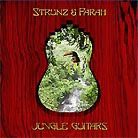This review page is supported in part by the sponsors whose ad banners are displayed below |
 |
 |
Not.
The HL2.2 rewrote expectations twice, once on bass, then on its mostly 'anti-ceramic' character. The compression-chamber loading of the mid/woofer's rear wave really did the promised business. It extends LF reach, creates very solid output at the pipe resonance frequency and surprising action below it, albeit literally stepped down as though one crossed a discrete threshold. This loading also seems to assist acoustic impedance matching. Even at high output, the driver undergoes less physical motion than expected. You can overdrive the little thing—I inadvertently did so once on the last track of Mercan Dede's Nefes with its powerful low-frequency heart beat spikes—but it takes some uncivilized doing. And you don't want to bang the stops on this driver whose membrane is physically quite brittle. I doubt it'll tolerate brainless abuse as nonchalantly as a pro-level paper driver might. |
|
|
|
|
Having heard Mårten Design and Kharma speakers to carry my own mixed bag of ceramic preconceptions, I was frankly unprepared for the wholesale absence of etch and whitishness this implementation of Accuton drivers celebrates. Recognizing their lust for power, I arguably had kicked off sessions with a best-case scenario with the mighty €15,000/pr Octave KT88-fitted MRE-130 monoblocks. But even amplifiers of their caliber can't turn swines into swans. While these speakers did all the expected disappearance tricks to soundstage like wanted bandits—all of that you've heard before—and were exceptionally astute in how they differentiated depth perception between different soundstage layers, they were not mechanical sewing machines whose entire raison d'être is on magnifying the transients. In fact, Triangle's Magellan Cello Sw2 in situ at the same time veered farther in that direction. And the French use a cellulose pulp (paper to us commoners) midrange. Geezus. This boggled the mind like so much gray jello. But then the ears have their own wisdom. They routinely are disinclined to hear what theory would want them to. (And the Triangle's treble does rise deliberately above 3,000Hz which the Albedo's does not.) |
 |
 |
Hot.
Believers in the audibility of time-domain fidelity probably agree. Treble sharpness is often a function of harmonic tweeter data which leads the midrange fundamentals of which the overtones are merely a function. In other words, effect precedes cause and the HF ingredients arriving a fraction too early are what cause the etch. The inverted Accuton tweeter in this Albedo speaker most assuredly does not—and this bears repeating because it flies in the face of expectations so here goes: does Not!—suffer any innate sharpness or fiery brilliance. Instead of Platinum white, the general treble tone here was rather a pale rosy gold. It suggested one of ex Stereophile scribe Jonathan Scull's favorite nouns: mellifluousness. It's fancy for sweet honeyed flow. And that's precisely the calling card of this speaker. Color me not a golden tan but blotty embarrassed red for having entertained such contrarious notions. |
|
Trot.
With that out of the way, the second round of undue cause fell on the incredibly well-damped, outright plucky bass. Where the whole Helmholtz resonator business—which of course also describes every vented alignment in the book—had perhaps predicted a somewhat ringy hollowness to pay for 'stolen' extension, reality once more interfered. Mostly. There was a specific and quite narrow mid-bass band that was boosted in amplitude and texturally a bit discontinuous. Aside from that though, it weren't just speed, articulation and bounce which characterized this bass as agile and perky. There also was a quite counter-intuitive wallop that really shouldn't have been considering how the HL2.2 has very small gloves to punch with.
 |
Naturally big powerful amplifiers are required to get the best in that regard. 100 glowing or 150 dark watts are probably advisable for the biggest damage these mid/woofers are capable of before crying Uncle. On all musical fare that routinely factors in my reviews, there really was nothing beyond the HL2.2s. But by the same token, I'm not one of those who expects a symphony of a thousand to fit into my living room at front-row levels. Headbangers, gut pounders and monster wave surfers better move on. It's when high SPLs and those frequencies which are additionally amplified by the Helmoline encounter violent spikes rather than steady-state signal that the narrow Accutone is most liable to exceed its grasp. Damping and the handling of back EMF are further variables which had me return to my Octave monos. Then all was hot to trot and the following paragraph covers the highlights. |
|
Barrelling down Albedo Avenue
The most powerful attribute of the Albedo HL.2.2 is soundstaging. Without etch, this speaker separates so uncannily that regardless of simultaneity compounding to the nth degree—look for your most complex recordings and cue up the densest of tracks—intelligibility never corrupts. The extent to which everything is assigned an unwavering locus regardless of how many different instruments get busy all over the place is extraordinary. While 2-ways and big symphonies might not seem natural friends, shy of obvious limits in energizing room air with big displacement when the kettle drums start to pound, the HL2.2 was very impressive in its refusal to get confused. In short, the Albedo highway has numerous exits marked 'Panorama Soundstage' to indicate that just like a large city, it's a main and big attraction. |
This seems a testament to high-level accuracy in the time domain as well as minimization of box talk. While soundstaging usually isn't terribly high on my list of wow buttons, I had to admit that this speaker was unusually endowed. Importantly, this did not come at a big price of analytical aloofness probably because this tweeter refused to slice 'n' dice up the virtual stage into a checker board. I found particularly impressive the sorting power in the layering direction. If you want to know how far away from your observer's point various performers are situated, this speaker will tell you without any ambiguity.
To reverse direction into minor liabilities, this speaker is somewhat cranky. One must crank the volume to beyond background fill and into the main focus zone before it gives of its best. Intelligibility won't default at lower levels—far from it in fact—but the sense of tone body shrinks and goes paler than desirable. This is true for any speaker but my Rethm Saadhana, Zu Essence and ASI Tango R keep the faith deeper into the shadows of quietude. |
|
|
 |
As you would expect from the above, the HL2.2 tracks complex rhythms with great clarity. For one, there's no time smear. Of additional assistance is the absence of a big woofer. Big woofers have a tendency to warm up the proceedings. Their warmth bleeds into the upper ranges that telegraph the fine tchikedee-tchikedee percussive stuff that propels the tunes along. While big whomp and infrasonic presence produce their own magic, a forté of more nimble-fingered small drivers is their on-the-money beat fidelity. |
|
| The Albedo HL2.2 isn't a cold hard speaker as its hard silver driver artillery could suggest. Neither is it warm and fuzzy, voluptuous, round or meaty. Nor is it super lit-up. The tonal balance in fact is very well centered. It does high-impact stuff astonishingly well for being a petite speaker and I predict that those attracted by its modern form factor will be very impressed by just how large it plays. The ideal client for it is someone who listens with her eyes - by which I'm not referring to cosmetics now but the fact that the spatial/dimensional and rhythmic precision is so high as to make the playback experience very visual. |
|
|
 |
The accomplishment
Like there are holes in Swiss cheese so the speaker world is riddled by claims and theories. Not all deliver or are as audible as their proponents make it sound.
Time/phase coherence is one of the more 'exotic' schools with rather fewer adherents. And it's true that in terms of hierarchy, grosser errors must be solved first before the time domain can assert itself. Any number of tonally flawed single-driver speakers would point at that for a start.
It also seems true that once one has gained sensitivity to time-induced errors—and gain here carries no superiority claim; ignorance can be bliss in enjoyment—there's nearly no turning back for such a listener to 'the other kind' of speakers.
That said, Thiel, Vandersteen and Green Mountain Audio to mention just three 1st-order brands sound nothing alike so there's more to the story than filter choice and sloping or stepped baffles. |
|
|
|
If you have deliberately acquired a no/1st-order preference or found yourself wired to always prefer such designs, Albedo's HL2.2 very obviously conforms. You needn't know that to hear it. Within that school, this Italian speaker has a greater similarity to Thiel than Vandersteen or GMA. The company's tag line Brightness in Sound is unfortunate in that it plays to the negative connotations 'bright' has acquired in hifi. It's assuredly not bright in that sense. But if by bright we mean a person with charisma—one who shines—then it's quite appropriate. This segues back also to the very high degree of visibility I mentioned earlier. If brightness means that you will see a lot very clearly because there's no obstructions, then too this tag line has merit. |
 |
Massimo Costa's real accomplishment with his Albedo HL2.2 is that it packages a true hi-performance design—superior for example to the previously reviewed 'high design' Danish Davone speaker—with refined style and solid engineering such as to make for a nearly perfect balance between the demands of the various involved disciplines which could have easily pulled in one direction or another to sacrifice the golden mean or middle path.
Coming back to the opening header about 'the world's most beautiful speaker?', reactions on cosmetics will diverge. They always do. But I don't think anyone would deny the Albedo high style. It might not be for you but it surely conveys itself that a gifted industrial designer has labored hard over every little detail. Nearly invariably, audiophile dogma suspects at best second-rate sonic performance as a result. But this Italian blonde not only has the curves, she's also got a very sharp brain and killer instincts. Rather than monkey coffins and laboratory equipment, that's where the future in speakers must surely lie - small, dialed and attractive and bona fide high-end not in bed but the listening seat. |
|
Quality of packing: To be improved.
Reusability of packing: Once.
Ease of unpacking/repacking: Easy.
Condition of component received: Perfect.
Completeness of delivery: By design, there are no grills.
Ease of assembly: None required. Plinth ships attached.
Website comments: Very informative, Italian/English translations suffer just a bit.
Human interactions: Prompt and forthcoming on all info requested.
Pricing: Commensurate with performance and for the concept and realization, more attractive than most.
Final comments & suggestions: The thin stem means there's a bit of give between enclosure and plinth. The short-ish blunt spikes won't work too well in deep pile carpet, ditto the current scheme of protectors. For such scenarios, Albedo should include longer pointy spikes or have them optionally available. |
|
 |
 |